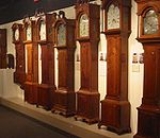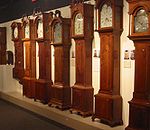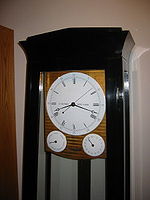
National Watch and Clock Museum
Encyclopedia
The National Watch and Clock Museum (USA) (NWCM), located in Columbia, Pennsylvania
, is one of a very few museums in the United States dedicated solely to horology
, which is the history, science and art of timekeeping and timekeepers.
Like its subsidiary institution, the NAWCC Library & Research Center, the National Watch and Clock Museum is operated by the National Association of Watch and Clock Collectors
(NAWCC), a non-profit organization
with about 21,000 members and an educational mission. The National Watch and Clock Museum was founded in 1977 by the NAWCC and over time has put together a major collection of horological artifacts, mainly clocks and watches, but also related tools, machinery and ephemera, and has become an important institution in its field.
Most of the greatest and most important clocks and watches ever made have been preserved and exhibited — for decades if not centuries — as decorative art in such major museums around the world as the British Museum
or the Metropolitan Museum in New York, or form a small department in the globally important museums of technology and science such as the Smithsonian Institution
, the Musée des Arts et Métiers
or the Deutsches Museum
. There are only few museums like NWCM, dedicated principally to the history of timekeeping, and the majority of them - located in former centers of horological production - have primarily a local or regional focus. Since the former "Time Museum" in Rockford, IL closed in the 1990s, the NWCM is often described as the broadest specialist horology museum in the country. (The only comparable museum in the United States is the American Watch and Clock Museum in Bristol, Conn.
, but that one is more focused on American-made timekeepers).
The museum, located on the fringe of the Pennsylvania Dutch tourist area, serves both a general public (including youth), as well as a specialised audience of horological aficionados (including NAWCC members), which appreciate its study collection and some of the more specialized temporary exhibits.
 The museum attempts to show the complete history of timekeepers from the first non-mechanical devices (sun-dials, hour-glasses, fire-clocks) to the atomic clock and mass-produced wristwatches of the present. There is a "Learning Center" introducing some of the basic technologies of the mechanical timekeeper, such as the pendulum, and a large and varied exhibit on many types of clock escapement
The museum attempts to show the complete history of timekeepers from the first non-mechanical devices (sun-dials, hour-glasses, fire-clocks) to the atomic clock and mass-produced wristwatches of the present. There is a "Learning Center" introducing some of the basic technologies of the mechanical timekeeper, such as the pendulum, and a large and varied exhibit on many types of clock escapement
. There is an excellent sample of American-made tall case clocks (popularly known as "grandfather clocks"), a comprehensive exhibit on American watches, and a small but excellent area dedicated to automatic machinery used in watch manufacturing. Other highlights include an exhibit of the pioneering automated machinery developed by the American Waltham Watch Company, allowing for the first time to mass-produce watches using interchangeable parts, a large selection of American pocket watches (including Railroad watches), and the "Engel Clock", a complicated "monument" clock built by Stephen Decatur Engel of Hazleton, Pennsylvania. This amazing clock took Engel about 20 years to complete, and it was shown for many years all around the United States starting in about 1877. The Engel clock disappeared in the early 1950s, and was found in a barn in New York State in 1983. The Engel clock was purchased and fully restored by the NAWCC in 1989 and is on display at the museum.
 The NWCM has an ongoing schedule of temporary exhibits — usually two of them at a time, one devoted to a general timekeeping-related theme of interest to the public, and the other a more specialized show appealing primarily to horological collectors.
The NWCM has an ongoing schedule of temporary exhibits — usually two of them at a time, one devoted to a general timekeeping-related theme of interest to the public, and the other a more specialized show appealing primarily to horological collectors.
Columbia, Pennsylvania
Columbia, once colonial Wright's Ferry, is a borough in Lancaster County, Pennsylvania, 28 miles southeast of Harrisburg on the left bank Susquehanna River across from Wrightsville and York County. Originally, the area may have been called Conejohela Flats, for the many islands and islets in the...
, is one of a very few museums in the United States dedicated solely to horology
Horology
Horology is the art or science of measuring time. Clocks, watches, clockwork, sundials, clepsydras, timers, time recorders and marine chronometers are all examples of instruments used to measure time.People interested in horology are called horologists...
, which is the history, science and art of timekeeping and timekeepers.
Like its subsidiary institution, the NAWCC Library & Research Center, the National Watch and Clock Museum is operated by the National Association of Watch and Clock Collectors
National Association of Watch and Clock Collectors
The National Association of Watch and Clock Collectors is an American non-profit organization with about 18,000 members.The NAWCC was founded in 1943 by members of the Horological Society of New York and the Philadelphia Watchmakers' Guild who wished to create a national organization...
(NAWCC), a non-profit organization
Non-profit organization
Nonprofit organization is neither a legal nor technical definition but generally refers to an organization that uses surplus revenues to achieve its goals, rather than distributing them as profit or dividends...
with about 21,000 members and an educational mission. The National Watch and Clock Museum was founded in 1977 by the NAWCC and over time has put together a major collection of horological artifacts, mainly clocks and watches, but also related tools, machinery and ephemera, and has become an important institution in its field.
Most of the greatest and most important clocks and watches ever made have been preserved and exhibited — for decades if not centuries — as decorative art in such major museums around the world as the British Museum
British Museum
The British Museum is a museum of human history and culture in London. Its collections, which number more than seven million objects, are amongst the largest and most comprehensive in the world and originate from all continents, illustrating and documenting the story of human culture from its...
or the Metropolitan Museum in New York, or form a small department in the globally important museums of technology and science such as the Smithsonian Institution
Smithsonian Institution
The Smithsonian Institution is an educational and research institute and associated museum complex, administered and funded by the government of the United States and by funds from its endowment, contributions, and profits from its retail operations, concessions, licensing activities, and magazines...
, the Musée des Arts et Métiers
Musée des Arts et Métiers
The Musée des Arts et Métiers is a museum in Paris that houses the collection of the Conservatoire National des Arts et Métiers , which was founded in 1794 as a repository for the preservation of scientific instruments and inventions.-History:Since its foundation, the museum has been housed in the...
or the Deutsches Museum
Deutsches Museum
The Deutsches Museum in Munich, Germany, is the world's largest museum of technology and science, with approximately 1.5 million visitors per year and about 28,000 exhibited objects from 50 fields of science and technology. The museum was founded on June 28, 1903, at a meeting of the Association...
. There are only few museums like NWCM, dedicated principally to the history of timekeeping, and the majority of them - located in former centers of horological production - have primarily a local or regional focus. Since the former "Time Museum" in Rockford, IL closed in the 1990s, the NWCM is often described as the broadest specialist horology museum in the country. (The only comparable museum in the United States is the American Watch and Clock Museum in Bristol, Conn.
Bristol, Connecticut
Bristol is a suburban city located in Hartford County, Connecticut, United States southwest of Hartford. According to 2006 Census Bureau estimates, the population of the city is 61,353. Bristol is primarily known as the home of ESPN, whose central studios are in the city. Bristol is also home to...
, but that one is more focused on American-made timekeepers).
The museum, located on the fringe of the Pennsylvania Dutch tourist area, serves both a general public (including youth), as well as a specialised audience of horological aficionados (including NAWCC members), which appreciate its study collection and some of the more specialized temporary exhibits.
Exhibits

Escapement
In mechanical watches and clocks, an escapement is a device that transfers energy to the timekeeping element and enables counting the number of oscillations of the timekeeping element...
. There is an excellent sample of American-made tall case clocks (popularly known as "grandfather clocks"), a comprehensive exhibit on American watches, and a small but excellent area dedicated to automatic machinery used in watch manufacturing. Other highlights include an exhibit of the pioneering automated machinery developed by the American Waltham Watch Company, allowing for the first time to mass-produce watches using interchangeable parts, a large selection of American pocket watches (including Railroad watches), and the "Engel Clock", a complicated "monument" clock built by Stephen Decatur Engel of Hazleton, Pennsylvania. This amazing clock took Engel about 20 years to complete, and it was shown for many years all around the United States starting in about 1877. The Engel clock disappeared in the early 1950s, and was found in a barn in New York State in 1983. The Engel clock was purchased and fully restored by the NAWCC in 1989 and is on display at the museum.

Similar museums
- American clock and watch museumAmerican Clock and Watch MuseumThe American Clock & Watch Museum , located in Bristol, Connecticut, is one of a very few museums in the United States dedicated solely to horology, which is the history, science and art of timekeeping and timekeepers...
- Cuckooland MuseumCuckooland MuseumThe Cuckooland Museum, previously known as the Cuckoo Clock Museum, is a museum that exhibits mainly cuckoo clocks, located in Tabley, co. Cheshire, England...
- Deutsches UhrenmuseumDeutsches UhrenmuseumThe German Clock Museum is situated near the centre of the Black Forest town of Furtwangen im Schwarzwald, a historic centre of clockmaking. It features permanent and temporary exhibits on the history of timekeeping...
- Mussee Internationale d'HorlogerieMussee Internationale d'HorlogerieMusée International d'Horlogerie is a museum located in La Chaux-de-Fonds, Switzerland, dedicated to horology, which is the study of time, timekeeping and timekeeping devices...
- Museum fũr Uhren und Mechanische Music
- Royal Observatory, GreenwichRoyal Observatory, GreenwichThe Royal Observatory, Greenwich , in London, England played a major role in the history of astronomy and navigation, and is best known as the location of the prime meridian...

